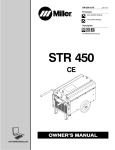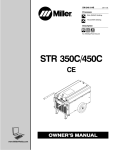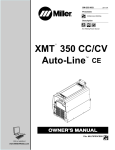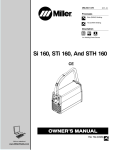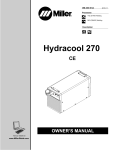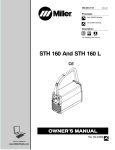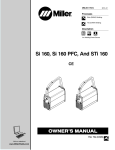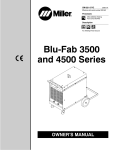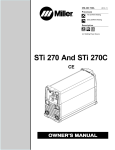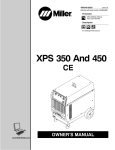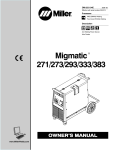Download Miller MigMatic 220 Owner`s manual
Transcript
OM-250 884A 2011−01 Processes MIG (GMAW) Welding Description Feeder Gun MigMatic 220DX/250DX Spool Gun R CE File: MIG (GMAW) Visit our website at www.MillerWelds.com From Miller to You Thank you and congratulations on choosing Miller. Now you can get the job done and get it done right. We know you don’t have time to do it any other way. That’s why when Niels Miller first started building arc welders in 1929, he made sure his products offered long-lasting value and superior quality. Like you, his customers couldn’t afford anything less. Miller products had to be more than the best they could be. They had to be the best you could buy. Today, the people that build and sell Miller products continue the tradition. They’re just as committed to providing equipment and service that meets the high standards of quality and value established in 1929. This Owner’s Manual is designed to help you get the most out of your Miller products. Please take time to read the Safety precautions. They will help you protect yourself against potential hazards on the worksite. We’ve made installation and operation quick and easy. With Miller you can count on years of reliable service with proper maintenance. And if for some reason the unit needs repair, there’s a Troubleshooting section that will help you figure out what the problem is. The Miller is the first welding parts list will then help you to decide the equipment manufacturer in exact part you may need to fix the problem. the U.S.A. to be registered to the ISO 9001 Quality System Warranty and service information for your Standard. particular model are also provided. Miller Electric manufactures a full line of welders and welding related equipment. For information on other quality Miller products, contact your local Miller distributor to receive the latest full line catalog or individual specification sheets. To locate your nearest distributor or service agency call 1-800-4-A-Miller, or visit us at www.MillerWelds.com on the web. Mil_Thank 2009−09 Working as hard as you do − every power source from Miller is backed by the most hassle-free warranty in the business. TABLE OF CONTENTS SECTION 1 − SAFETY PRECAUTIONS - READ BEFORE USING . . . . . . . . . . . . . . . . . . . . . . . . . . . . . . . . . 1-1. Symbol Usage . . . . . . . . . . . . . . . . . . . . . . . . . . . . . . . . . . . . . . . . . . . . . . . . . . . . . . . . . . . . . . . . . . . . . . . 1-2. Arc Welding Hazards . . . . . . . . . . . . . . . . . . . . . . . . . . . . . . . . . . . . . . . . . . . . . . . . . . . . . . . . . . . . . . . . . 1-3. Additional Symbols For Installation, Operation, And Maintenance . . . . . . . . . . . . . . . . . . . . . . . . . . . . . 1-4. California Proposition 65 Warnings . . . . . . . . . . . . . . . . . . . . . . . . . . . . . . . . . . . . . . . . . . . . . . . . . . . . . . 1-5. Principal Safety Standards . . . . . . . . . . . . . . . . . . . . . . . . . . . . . . . . . . . . . . . . . . . . . . . . . . . . . . . . . . . . . 1-6. EMF Information . . . . . . . . . . . . . . . . . . . . . . . . . . . . . . . . . . . . . . . . . . . . . . . . . . . . . . . . . . . . . . . . . . . . . SECTION 3 − INSTALLATION . . . . . . . . . . . . . . . . . . . . . . . . . . . . . . . . . . . . . . . . . . . . . . . . . . . . . . . . . . . . . . . . 3-1. Important Information Regarding CE Products (Sold Within The EU) . . . . . . . . . . . . . . . . . . . . . . . . . . 3-2. Specifications . . . . . . . . . . . . . . . . . . . . . . . . . . . . . . . . . . . . . . . . . . . . . . . . . . . . . . . . . . . . . . . . . . . . . . . . 3-3. Connecting Spool Gun To MigMatic 220DX/250DX . . . . . . . . . . . . . . . . . . . . . . . . . . . . . . . . . . . . . . . . . 3-4. Opening Cover . . . . . . . . . . . . . . . . . . . . . . . . . . . . . . . . . . . . . . . . . . . . . . . . . . . . . . . . . . . . . . . . . . . . . . 3-5. Installing Wire Spool And Threading Welding Wire . . . . . . . . . . . . . . . . . . . . . . . . . . . . . . . . . . . . . . . . . 3-6. Adjusting Drive Roll And Spool Brake Pressure . . . . . . . . . . . . . . . . . . . . . . . . . . . . . . . . . . . . . . . . . . . 3-7. Adjusting Position Of Spool Canister . . . . . . . . . . . . . . . . . . . . . . . . . . . . . . . . . . . . . . . . . . . . . . . . . . . . . SECTION 4 − OPERATION . . . . . . . . . . . . . . . . . . . . . . . . . . . . . . . . . . . . . . . . . . . . . . . . . . . . . . . . . . . . . . . . . . . 4-1. Controls . . . . . . . . . . . . . . . . . . . . . . . . . . . . . . . . . . . . . . . . . . . . . . . . . . . . . . . . . . . . . . . . . . . . . . . . . . . . 4-2. Shielding Gas . . . . . . . . . . . . . . . . . . . . . . . . . . . . . . . . . . . . . . . . . . . . . . . . . . . . . . . . . . . . . . . . . . . . . . . . SECTION 5 − MAINTENANCE & TROUBLESHOOTING . . . . . . . . . . . . . . . . . . . . . . . . . . . . . . . . . . . . . . . . . 5-1. Routine Maintenance . . . . . . . . . . . . . . . . . . . . . . . . . . . . . . . . . . . . . . . . . . . . . . . . . . . . . . . . . . . . . . . . . 5-2. Changing Gun Contact Tip . . . . . . . . . . . . . . . . . . . . . . . . . . . . . . . . . . . . . . . . . . . . . . . . . . . . . . . . . . . . . 5-3. Replacing Inlet Guide . . . . . . . . . . . . . . . . . . . . . . . . . . . . . . . . . . . . . . . . . . . . . . . . . . . . . . . . . . . . . . . . . 5-4. Gun Drive Assembly Maintenance . . . . . . . . . . . . . . . . . . . . . . . . . . . . . . . . . . . . . . . . . . . . . . . . . . . . . . 5-5. Troubleshooting . . . . . . . . . . . . . . . . . . . . . . . . . . . . . . . . . . . . . . . . . . . . . . . . . . . . . . . . . . . . . . . . . . . . . . SECTION 6 − ELECTRICAL DIAGRAM . . . . . . . . . . . . . . . . . . . . . . . . . . . . . . . . . . . . . . . . . . . . . . . . . . . . . . . . SECTION 6 − PARTS LIST . . . . . . . . . . . . . . . . . . . . . . . . . . . . . . . . . . . . . . . . . . . . . . . . . . . . . . . . . . . . . . . . . . . WARRANTY 1 1 1 3 4 4 4 5 5 5 6 7 8 9 10 11 11 11 12 12 12 13 14 14 15 16 DECLARATION OF CONFORMITY for European Community (CE marked) products. ITW Welding Products Italy S.r.l Via Privata Iseo 6/E, 20098 San Giuliano M.se, (MI) Italy declares that the product(s) identified in this declaration conform to the essential requirements and provisions of the stated Council Directive(s) and Standard(s). Product/Apparatus Identification: Product Stock Number MigMatic 220DX/250DX SPOOL GUN W/EURO+BZ 058020018 MigMatic 220DX/250DX SPOOL GUN W/EURO PLASTIC BOX 058020019 Council Directives: • 2006/95/EC Low Voltage Standards: • IEC 609741 Arc Welding Equipment Welding Power Sources: edition 3, 200507. • IEC 609747 Arc Welding Equipment Torches: edition 2, 200507. • EN 50445:2008 Product family standard to demonstrate compliance of equipment for resistance welding, arc welding and allied processes with the basic restrictions related to human exposure to electromagnetic fields (0Hz300Hz) EU Signatory: December 17th, 2010 ___________________________________________________________________________________ Massimigliano Lavarini Date of Declaration ELECTRONIC ENGINEER R&D TECH. SUPPORT 956 142 843 SECTION 1 − SAFETY PRECAUTIONS - READ BEFORE USING som _2010−03 7 Protect yourself and others from injury — read and follow these precautions. 1-1. Symbol Usage DANGER! − Indicates a hazardous situation which, if not avoided, will result in death or serious injury. The possible hazards are shown in the adjoining symbols or explained in the text. Indicates a hazardous situation which, if not avoided, could result in death or serious injury. The possible hazards are shown in the adjoining symbols or explained in the text. NOTICE − Indicates statements not related to personal injury. . Indicates special instructions. This group of symbols means Warning! Watch Out! ELECTRIC SHOCK, MOVING PARTS, and HOT PARTS hazards. Consult symbols and related instructions below for necessary actions to avoid the hazards. 1-2. Arc Welding Hazards The symbols shown below are used throughout this manual to call attention to and identify possible hazards. When you see the symbol, watch out, and follow the related instructions to avoid the hazard. The safety information given below is only a summary of the more complete safety information found in the Safety Standards listed in Section 1-5. Read and follow all Safety Standards. Only qualified persons should install, operate, maintain, and repair this unit. During operation, keep everybody, especially children, away. D Always verify the supply ground − check and be sure that input power cord ground wire is properly connected to ground terminal in disconnect box or that cord plug is connected to a properly grounded receptacle outlet. D When making input connections, attach proper grounding conductor first − double-check connections. D Keep cords dry, free of oil and grease, and protected from hot metal and sparks. D Frequently inspect input power cord for damage or bare wiring − replace cord immediately if damaged − bare wiring can kill. D Turn off all equipment when not in use. D Do not use worn, damaged, undersized, or poorly spliced cables. ELECTRIC SHOCK can kill. Touching live electrical parts can cause fatal shocks or severe burns. The electrode and work circuit is electrically live whenever the output is on. The input power circuit and machine internal circuits are also live when power is on. In semiautomatic or automatic wire welding, the wire, wire reel, drive roll housing, and all metal parts touching the welding wire are electrically live. Incorrectly installed or improperly grounded equipment is a hazard. D Do not touch live electrical parts. D Wear dry, hole-free insulating gloves and body protection. D Insulate yourself from work and ground using dry insulating mats or covers big enough to prevent any physical contact with the work or ground. D Do not use AC output in damp areas, if movement is confined, or if there is a danger of falling. D Use AC output ONLY if required for the welding process. D If AC output is required, use remote output control if present on unit. D Additional safety precautions are required when any of the following electrically hazardous conditions are present: in damp locations or while wearing wet clothing; on metal structures such as floors, gratings, or scaffolds; when in cramped positions such as sitting, kneeling, or lying; or when there is a high risk of unavoidable or accidental contact with the workpiece or ground. For these conditions, use the following equipment in order presented: 1) a semiautomatic DC constant voltage (wire) welder, 2) a DC manual (stick) welder, or 3) an AC welder with reduced open-circuit voltage. In most situations, use of a DC, constant voltage wire welder is recommended. And, do not work alone! D Disconnect input power or stop engine before installing or servicing this equipment. Lockout/tagout input power according to OSHA 29 CFR 1910.147 (see Safety Standards). D Properly install and ground this equipment according to its Owner’s Manual and national, state, and local codes. D Do not drape cables over your body. D If earth grounding of the workpiece is required, ground it directly with a separate cable. D Do not touch electrode if you are in contact with the work, ground, or another electrode from a different machine. D Do not touch electrode holders connected to two welding machines at the same time since double open-circuit voltage will be present. D Use only well-maintained equipment. Repair or replace damaged parts at once. Maintain unit according to manual. D Wear a safety harness if working above floor level. D Keep all panels and covers securely in place. D Clamp work cable with good metal-to-metal contact to workpiece or worktable as near the weld as practical. D Insulate work clamp when not connected to workpiece to prevent contact with any metal object. D Do not connect more than one electrode or work cable to any single weld output terminal. SIGNIFICANT DC VOLTAGE exists in inverter welding power sources AFTER removal of input power. D Turn Off inverter, disconnect input power, and discharge input capacitors according to instructions in Maintenance Section before touching any parts. HOT PARTS can burn. D Do not touch hot parts bare handed. D Allow cooling period before working on equipment. D To handle hot parts, use proper tools and/or wear heavy, insulated welding gloves and clothing to prevent burns. OM-250 884 Page 1 FUMES AND GASES can be hazardous. Welding produces fumes and gases. Breathing these fumes and gases can be hazardous to your health. D Keep your head out of the fumes. Do not breathe the fumes. D If inside, ventilate the area and/or use local forced ventilation at the arc to remove welding fumes and gases. D If ventilation is poor, wear an approved air-supplied respirator. D Read and understand the Material Safety Data Sheets (MSDSs) and the manufacturer’s instructions for metals, consumables, coatings, cleaners, and degreasers. D Work in a confined space only if it is well ventilated, or while wearing an air-supplied respirator. Always have a trained watchperson nearby. Welding fumes and gases can displace air and lower the oxygen level causing injury or death. Be sure the breathing air is safe. D Do not weld in locations near degreasing, cleaning, or spraying operations. The heat and rays of the arc can react with vapors to form highly toxic and irritating gases. D Do not weld on coated metals, such as galvanized, lead, or cadmium plated steel, unless the coating is removed from the weld area, the area is well ventilated, and while wearing an air-supplied respirator. The coatings and any metals containing these elements can give off toxic fumes if welded. D Remove stick electrode from holder or cut off welding wire at contact tip when not in use. D Wear oil-free protective garments such as leather gloves, heavy shirt, cuffless trousers, high shoes, and a cap. D Remove any combustibles, such as a butane lighter or matches, from your person before doing any welding. D After completion of work, inspect area to ensure it is free of sparks, glowing embers, and flames. D Use only correct fuses or circuit breakers. Do not oversize or bypass them. D Follow requirements in OSHA 1910.252 (a) (2) (iv) and NFPA 51B for hot work and have a fire watcher and extinguisher nearby. FLYING METAL or DIRT can injure eyes. D Welding, chipping, wire brushing, and grinding cause sparks and flying metal. As welds cool, they can throw off slag. D Wear approved safety glasses with side shields even under your welding helmet. BUILDUP OF GAS can injure or kill. D Shut off shielding gas supply when not in use. D Always ventilate confined spaces or use approved air-supplied respirator. ARC RAYS can burn eyes and skin. Arc rays from the welding process produce intense visible and invisible (ultraviolet and infrared) rays that can burn eyes and skin. Sparks fly off from the weld. D Wear an approved welding helmet fitted with a proper shade of filter lenses to protect your face and eyes from arc rays and sparks when welding or watching (see ANSI Z49.1 and Z87.1 listed in Safety Standards). D Wear approved safety glasses with side shields under your helmet. D Use protective screens or barriers to protect others from flash, glare and sparks; warn others not to watch the arc. D Wear protective clothing made from durable, flame-resistant material (leather, heavy cotton, or wool) and foot protection. WELDING can cause fire or explosion. Welding on closed containers, such as tanks, drums, or pipes, can cause them to blow up. Sparks can fly off from the welding arc. The flying sparks, hot workpiece, and hot equipment can cause fires and burns. Accidental contact of electrode to metal objects can cause sparks, explosion, overheating, or fire. Check and be sure the area is safe before doing any welding. D Remove all flammables within 35 ft (10.7 m) of the welding arc. If this is not possible, tightly cover them with approved covers. D Do not weld where flying sparks can strike flammable material. D Protect yourself and others from flying sparks and hot metal. D Be alert that welding sparks and hot materials from welding can easily go through small cracks and openings to adjacent areas. D Watch for fire, and keep a fire extinguisher nearby. D Be aware that welding on a ceiling, floor, bulkhead, or partition can cause fire on the hidden side. D Do not weld on closed containers such as tanks, drums, or pipes, unless they are properly prepared according to AWS F4.1 (see Safety Standards). D Do not weld where the atmosphere may contain flammable dust, gas, or liquid vapors (such as gasoline). D Connect work cable to the work as close to the welding area as practical to prevent welding current from traveling long, possibly unknown paths and causing electric shock, sparks, and fire hazards. D Do not use welder to thaw frozen pipes. OM-250 884 Page 2 ELECTRIC AND MAGNETIC FIELDS (EMF) can affect Implanted Medical Devices. D Wearers of Pacemakers and other Implanted Medical Devices should keep away. D Implanted Medical Device wearers should consult their doctor and the device manufacturer before going near arc welding, spot welding, gouging, plasma arc cutting, or induction heating operations. NOISE can damage hearing. Noise from some processes or equipment can damage hearing. D Wear approved ear protection if noise level is high. CYLINDERS can explode if damaged. Shielding gas cylinders contain gas under high pressure. If damaged, a cylinder can explode. Since gas cylinders are normally part of the welding process, be sure to treat them carefully. D Protect compressed gas cylinders from excessive heat, mechanical shocks, physical damage, slag, open flames, sparks, and arcs. D Install cylinders in an upright position by securing to a stationary support or cylinder rack to prevent falling or tipping. D Keep cylinders away from any welding or other electrical circuits. D Never drape a welding torch over a gas cylinder. D Never allow a welding electrode to touch any cylinder. D Never weld on a pressurized cylinder − explosion will result. D Use only correct shielding gas cylinders, regulators, hoses, and fittings designed for the specific application; maintain them and associated parts in good condition. D Turn face away from valve outlet when opening cylinder valve. D Keep protective cap in place over valve except when cylinder is in use or connected for use. D Use the right equipment, correct procedures, and sufficient number of persons to lift and move cylinders. D Read and follow instructions on compressed gas cylinders, associated equipment, and Compressed Gas Association (CGA) publication P-1 listed in Safety Standards. 1-3. Additional Symbols For Installation, Operation, And Maintenance FIRE OR EXPLOSION hazard. D Do not install or place unit on, over, or near combustible surfaces. D Do not install unit near flammables. D Do not overload building wiring − be sure power supply system is properly sized, rated, and protected to handle this unit. FALLING EQUIPMENT can injure. D Use lifting eye to lift unit only, NOT running gear, gas cylinders, or any other accessories. D Use equipment of adequate capacity to lift and support unit. D If using lift forks to move unit, be sure forks are long enough to extend beyond opposite side of unit. D Keep equipment (cables and cords) away from moving vehicles when working from an aerial location. D Follow the guidelines in the Applications Manual for the Revised NIOSH Lifting Equation (Publication No. 94−110) when manually lifting heavy parts or equipment. MOVING PARTS can injure. D Keep away from moving parts such as fans. D Keep all doors, panels, covers, and guards closed and securely in place. D Have only qualified persons remove doors, panels, covers, or guards for maintenance and troubleshooting as necessary. D Reinstall doors, panels, covers, or guards when maintenance is finished and before reconnecting input power. READ INSTRUCTIONS. D Read and follow all labels and the Owner’s Manual carefully before installing, operating, or servicing unit. Read the safety information at the beginning of the manual and in each section. D Use only genuine replacement parts from the manufacturer. D Perform maintenance and service according to the Owner’s Manuals, industry standards, and national, state, and local codes. OVERUSE can cause OVERHEATING H.F. RADIATION can cause interference. D Allow cooling period; follow rated duty cycle. D Reduce current or reduce duty cycle before starting to weld again. D Do not block or filter airflow to unit. FLYING SPARKS can injure. D Wear a face shield to protect eyes and face. D Shape tungsten electrode only on grinder with proper guards in a safe location wearing proper face, hand, and body protection. D Sparks can cause fires — keep flammables away. D D D D STATIC (ESD) can damage PC boards. D Put on grounded wrist strap BEFORE handling boards or parts. D Use proper static-proof bags and boxes to store, move, or ship PC boards. ARC WELDING can cause interference. MOVING PARTS can injure. D Keep away from moving parts. D Keep away from pinch points such as drive rolls. WELDING WIRE can injure. D Do not press gun trigger until instructed to do so. D Do not point gun toward any part of the body, other people, or any metal when threading welding wire. D High-frequency (H.F.) can interfere with radio navigation, safety services, computers, and communications equipment. D Have only qualified persons familiar with electronic equipment perform this installation. The user is responsible for having a qualified electrician promptly correct any interference problem resulting from the installation. If notified by the FCC about interference, stop using the equipment at once. Have the installation regularly checked and maintained. Keep high-frequency source doors and panels tightly shut, keep spark gaps at correct setting, and use grounding and shielding to minimize the possibility of interference. D D D D D Electromagnetic energy can interfere with sensitive electronic equipment such as computers and computer-driven equipment such as robots. D Be sure all equipment in the welding area is electromagnetically compatible. To reduce possible interference, keep weld cables as short as possible, close together, and down low, such as on the floor. Locate welding operation 100 meters from any sensitive electronic equipment. Be sure this welding machine is installed and grounded according to this manual. If interference still occurs, the user must take extra measures such as moving the welding machine, using shielded cables, using line filters, or shielding the work area. OM-250 884 Page 3 1-4. California Proposition 65 Warnings Welding or cutting equipment produces fumes or gases which contain chemicals known to the State of California to cause birth defects and, in some cases, cancer. (California Health & Safety Code Section 25249.5 et seq.) Battery posts, terminals and related accessories contain lead and lead compounds, chemicals known to the State of California to cause cancer and birth defects or other reproductive harm. Wash hands after handling. For Gasoline Engines: Engine exhaust contains chemicals known to the State of California to cause cancer, birth defects, or other reproductive harm. For Diesel Engines: Diesel engine exhaust and some of its constituents are known to the State of California to cause cancer, birth defects, and other reproductive harm. This product contains chemicals, including lead, known to the state of California to cause cancer, birth defects, or other reproductive harm. Wash hands after use. 1-5. Principal Safety Standards Safety in Welding, Cutting, and Allied Processes, ANSI Standard Z49.1, from Global Engineering Documents (phone: 1-877-413-5184, website: www.global.ihs.com). Safe Practices for the Preparation of Containers and Piping for Welding and Cutting, American Welding Society Standard AWS F4.1, from Global Engineering Documents (phone: 1-877-413-5184, website: www.global.ihs.com). National Electrical Code, NFPA Standard 70, from National Fire Protection Association, Quincy, MA 02269 (phone: 1-800-344-3555, website: www.nfpa.org and www. sparky.org). Safe Handling of Compressed Gases in Cylinders, CGA Pamphlet P-1, from Compressed Gas Association, 4221 Walney Road, 5th Floor, Chantilly, VA 20151 (phone: 703-788-2700, website:www.cganet.com). Safety in Welding, Cutting, and Allied Processes, CSA Standard W117.2, from Canadian Standards Association, Standards Sales, 5060 Spectrum Way, Suite 100, Ontario, Canada L4W 5NS (phone: 800-463-6727, website: www.csa-international.org). Safe Practice For Occupational And Educational Eye And Face Protection, ANSI Standard Z87.1, from American National Standards Institute, 25 West 43rd Street, New York, NY 10036 (phone: 212-642-4900, website: www.ansi.org). Standard for Fire Prevention During Welding, Cutting, and Other Hot Work, NFPA Standard 51B, from National Fire Protection Association, Quincy, MA 02269 (phone: 1-800-344-3555, website: www.nfpa.org. OSHA, Occupational Safety and Health Standards for General Industry, Title 29, Code of Federal Regulations (CFR), Part 1910, Subpart Q, and Part 1926, Subpart J, from U.S. Government Printing Office, Superintendent of Documents, P.O. Box 371954, Pittsburgh, PA 15250-7954 (phone: 1-866-512-1800) (there are 10 OSHA Regional Offices— phone for Region 5, Chicago, is 312-353-2220, website: www.osha.gov). U.S. Consumer Product Safety Commission (CPSC), 4330 East West Highway, Bethesda, MD 20814 (phone: 301-504-7923, website: www.cpsc.gov). Applications Manual for the Revised NIOSH Lifting Equation, The National Institute for Occupational Safety and Health (NIOSH), 1600 Clifton Rd, Atlanta, GA 30333 (phone: 1-800-232-4636, website: www.cdc.gov/NIOSH). 1-6. EMF Information Electric current flowing through any conductor causes localized electric and magnetic fields (EMF). Welding current creates an EMF field around the welding circuit and welding equipment. EMF fields may interfere with some medical implants, e.g. pacemakers. Protective measures for persons wearing medical implants have to be taken. For example, access restrictions for passers−by or individual risk assessment for welders. All welders should use the following procedures in order to minimize exposure to EMF fields from the welding circuit: 1. Keep cables close together by twisting or taping them, or using a cable cover. 2. Do not place your body between welding cables. Arrange cables to one side and away from the operator. 3. Do not coil or drape cables around your body. OM-250 884 Page 4 4. Keep head and trunk as far away from the equipment in the welding circuit as possible. 5. Connect work clamp to workpiece as close to the weld as possible. 6. Do not work next to, sit or lean on the welding power source. 7. Do not weld whilst carrying the welding power source or wire feeder. About Implanted Medical Devices: Implanted Medical Device wearers should consult their doctor and the device manufacturer before performing or going near arc welding, spot welding, gouging, plasma arc cutting, or induction heating operations. If cleared by your doctor, then following the above procedures is recommended. SECTION 2 − INSTALLATION 2-1. Important Information Regarding CE Products (Sold Within The EU) A. Information On Electromagnetic Fields (EMF) ! This equipment shall not be used by the general public as the EMF limits for the general public might be exceeded during welding. This equipment is built in accordance with EN 60974−1 and is intended to be used only in an occupational environment (where the general public access is prohibited or regulated in such a way as to be similar to occupational use) by an expert or an instructed person. Wire feeders and ancillary equipment (such as torches, liquid cooling systems and arc striking and stabilizing devices) as part of the welding circuit may not be a major contributor to the EMF. See the Owner’s Manuals for all components of the welding circuit for additional EMF exposure information. S S The EMF assessment on this equipment was conducted at 0.5 meter. At a distance of 1 meter the EMF exposure values were less than 20% of the permissible values. ce-emf 1 2010-10 2-2. Specifications Wire Diameter Range 0.8 Thru 1.0 mm (.030 Thru .039 in.) Aluminum Wire 0.8 Thru 1.0 mm (.023 Thru 039 in.) Solid Or Cored Wire Approximate Wire Feed Range 1 To 22 mpm (39.4 To 866 ipm) Cooling Method Air Cooled Maximum Spool Size 100 mm (4 in.) Diameter Weld Circuit Rating Overall Dimensions 190 Amperes, 60% Duty Cycle Using CO2 Length: 410 mm (16.14 in.) 160 Amperes, 60% Duty Cycle Using MIX Height: 290 mm (11.4 in.) Width: 100 mm (3.94 in.) Weight 4.8 kg (10.6 lb) Gun With Cable . Use welding power source Owner’s Manual during gun installation. If contact tip, liner, and drive roll groove are not correct for wire size and type, see Section 4 to change parts as needed. See Parts List for other available contact tips. Notes OM-250 884 Page 5 2-3. Connecting Spool Gun To MigMatic 220DX/250DX . See the MigMatic 220DX/250DX Owner’s Manual for additional information on connecting and operating the spool gun. . The spool gun works only with the welding power source in the Manual mode and Wire feed speed is controlled by the spool gun Wire Speed control (see Section 3-1). If the welding power source is in the Synergic mode, the spool gun works only with Aluminum wire. . There is no weld output and the welding power source Digital Display Meter displays three dashes (_ _ _) if weld parameters (wire diameter and type) are incorrect. 2 1 1 Spool Gun Mode LED The Spool Gun Mode LED lights and the 2T and 4T trigger modes are disabled when a spool gun is connected to the 7−pin receptacle. 3 2 3 Spool Gun 7-Pin Receptacle Spool Gun 7-Pin Plug Insert plug into receptacle and tighten threaded collar. The Spool Gun Mode LED lights. 4 5 5 6 4 MIG Torch Receptacle MIG Torch Plug Insert plug into receptacle and tighten threaded collar. 6 Regulator/Flowmeter Route shielding gas hose up to regulator/flowmeter. Connect gas hose to fitting on regulator/flowmeter. Insert other end of gas hose into gas valve connector. Tools Needed: 3/4, 5/8 in. OM-250 884 Page 6 Ref 956142722_2-12_A 2-4. Opening Cover 1 1 Thumbscrew 2 Cover Loosen thumbscrew and rotate cover open. 2 Ref. 956142722_3-12_A Notes OM-250 884 Page 7 2-5. Installing Wire Spool And Threading Welding Wire 1 2 3 Cover Canister Thumbscrew (Cover) Loosen thumbscrew and remvoe cover. 4 Wire Spool Loosen wire from spool, cut off bent wire, and pull 6 in. (150 mm) of wire off spool. 5 Pressure Roll Assembly Press arm inward to open pressure roll assembly. 6 6 7 8 7 Wire Inlet Guide Drive Roll Groove Contact Tip Thread wire through wire inlet guide, along drive roll groove, and out contact tip. 5 Install spool so wire feeds off bottom. See Section 2-7 for information on adjusting spool position. 9 Spool Brake Thumbnut If necessary, turn thumbnut counterclockwise slightly to install spool. 2 Close cover and secure with thumbscrew. 9 4 1 8 3 Tools Needed: Ref. 956142722_4-12_A OM-250 884 Page 8 2-6. Adjusting Drive Roll And Spool Brake Pressure 1 2 Cover Thumbscrew Loosen thumbscrew and rotate cover open. 3 Spool Cut welding wire off at contact tip. Retract wire onto spool and secure wire. 4 5 Spool Brake Thumbnut Grasp spool in one hand and turn spool while adjusting spool brake thumbnut. When a slight force is needed to turn spool, tension is set. Do not overtighten. Thread welding wire (see Section 2-5). 5 Drive Roll Tension Thumbnut Turn On unit and check drive roll pressure by feeding wire against a wood board or concrete surface; wire should feed steadily without slipping. Adjust drive roll tension thumbnut if necessary. Do not overtighten. ! Turn off source. welding power Close cover. 3 4 1 2 Adjusting Pressure Tools Needed: WOOD Ref. 956142722_5-12_A OM-250 884 Page 9 2-7. Adjusting Position Of Spool Canister Tools Needed: The canister can be moved to three positions. Before welding, move the spool canister to the position that allows the gun to be handled most comfortably. Spool Wire Position 1 Canister Adjustment Screw Loosen screw and move spool canister to the desired position. Tighten screw. Note position of canister. 1 Spool Wire Position Note position of canister. 1 Ref. 956142722_6-12_A OM-250 884 Page 10 SECTION 3 − OPERATION 3-1. Controls 1 Trigger Press trigger to energize welding power source contactor (if applicable), start shielding gas flow, and begin wire feed. For shielding gas preflow and postflow, lightly press trigger before and after welding. 2 Wire Speed Control Use control to adjust wire feed speed. Rotate control clockwise to increase wire feed speed. . See the MigMatic 220DX/250DX Owner’s Manual for additional information on connecting and operating the spool gun. . The spool gun works only with the welding power source in the Manual mode. If the welding power source is in the Synergic mode, the spool gun works only with Aluminum wire. . There is no weld output and the 1 welding power source Digital Display Meter displays three dashes (_ _ _) if weld parameters (wire diameter and type) are incorrect. 2 Ref. 956142722_7-12_A 3-2. Shielding Gas 1 2 3 Shielding Gas Cylinder Valve Gun Trigger Open valve on cylinder just before welding. Gun trigger turns weld output and gas flow on and off. For shielding gas preflow and postflow, lightly press trigger before and after welding. 2 1 Close valve on cylinder when finished welding. 3 sb5.1* 6/92 − S-0621-C / Ref. 956142722_7-12_A OM-250 884 Page 11 SECTION 4 − MAINTENANCE & TROUBLESHOOTING 4-1. Routine Maintenance ! . Maintain more often Disconnect power before maintaining. during severe conditions. 3 Months Replace Damaged Or Unreadable Labels Clean And Tighten Weld Terminals Replace Damage Gas Hose Repair Or Replace Cracked Cables And Cords 6 Months Blow Out Or Vacuum Inside Clean Drive Rolls 4-2. Changing Gun Contact Tip ! Turn off welding power source. 1 Nozzle 2 Contact Tip 3 Tension Spring Remove nozzle Unscrew contact tip. Install new contact tip. 3 Reinstall nozzle. The tension spring allows the nozzle to be connected to the shaft. 1 2 Tools Needed: Ref. 956142722_9-12_A OM-250 884 Page 12 4-3. Replacing Inlet Guide 5 6 ! Turn off source. 1 Pressure Roll Assembly welding power Cut off welding wire where it enters pressure roll assembly area. 2 Nozzle Pull wire out nozzle end. 4 3 4 Thumbscrew Cover Loosen thumbscrew and remove cover. 5 6 2 Wire Spool Spool Brake Thumbnut Loosen thumbnut, retract wire onto spool, secure wire, and remove spool. 7 3 Inlet Guide Use pliers to remove inlet guide. Install new guide. Reinstall spool and thread welding wire (see Section 2-5). Adjust spool brake pressure and drive roll pressure if necessary (see Section 2-6). Reinstall cover. 7 1 Tools Needed: Ref. 956142722_10-12_A OM-250 884 Page 13 4-4. Gun Drive Assembly Maintenance ! Turn off source. welding power Retract wire onto spool. 1 Drive Roll Cap Rotate drive roller cap counterclockwise and remove it from the drive roller. 2 Drive Roll Loosen set screw and remove drive roll. Use wire brush to clean drive roll. Install drive roll with desired groove down; rotate drive roll so set screw faces flat side of shaft. Tighten set screw. 3 4 Pressure Roll Assembly Bearing Open pressure roll assembly to access bearing. Use proper brush to clean bearing. Thread welding wire through gun (see Section 2-5). Adjust drive roll pressure, if necessary (see Section 2-6). Close and secure cover. 1 2 Tools Needed: 4 3 Ref. 956142722_11-12_B 4-5. Troubleshooting Trouble Remedy No weld output; gun/feeder does not Place Power switch on welding power source in the On position (see welding power source Owner’s work. Manual). Erratic weld output. Tighten and clean all connections. Wire feeds, shielding gas flows, but See Troubleshooting section in welding power source Owner’s Manual. welding wire is not energized. Wire feeds erratically. Check and correct drive roll pressure (see Section 2-6). Clean drive roll or replace drive roll (see Section 4-4). Decrease spool brake pressure (see Section 2-6). OM-250 884 Page 14 SECTION 5 − ELECTRICAL DIAGRAM 956142723-A Figure 6-1. Circuit Diagram For Gun/Feeder OM-243 762 Page 15 1 2 24 3 OM-250 884 Page 16 Figure 7-1. Complete Assembly 4 25 24 25 5 6 39 25 7 26 24 25 8 27 26 21 20 9 10 18 26 22 28 12 29 13 14 11 19 17 15 23 30 31 16 26 32 36 35 34 33 26 37 14 38 not available unless listed. . Hardware is common and SECTION 6 − PARTS LIST 956142722_12-12_A Item No. Dia. Mkgs. Part No. Description Quantity Figure 7-1. Complete Assembly . . . 1 . . . . . . . . . 057054060 . . . 2 . . . . . . . . . 256095074 . . . . . . . . . . . . . . . 256095076 . . . 3 . . . . . . . . . 556081130 . . . 4 . . . . . . . . . 156032131 . . . 5 . . . . . . . . . 756033045 . . . 6 . . . . . . . . . 656026124 . . . 7 . . . . . . . . . 656033008 . . . 8 . . . . . . . . . 057017043 . . . 9 . . . . . . . . . 656021267 . . . 10 . . . . . . . . . 156019769 . . . 11 . . . . . . . . . 156019770 . . . 12 . . . . . . . . . 656081026 . . . 13 . . . . . . . . . 556075031 . . . 14 . . . . . . . . . 656021268 . . . 15 . . . . . . . . . 056100106 . . . 16 . . . . . . . . . 556043012 . . . 17 . . . . . . . . . 156019771 . . . 18 . . . . . . . . . 156019772 . . . 19 . . . . . . . . . 156053111 . . . 20 . . . . . . . . . 057021024 . . . 21 . . . . . . . . . 156018119 . . . 22 . . . . . . . . . 556049406 . . . 23 . . . M . . 056126078 . . . 24 . . . . . . . . . 156019773 . . . 25 . . . . . . . . . 157019774 . . . 26 . . . . . . . . . 058066067 . . . 27 . . . S1 . . 056093024 . . . 28 . . . R1 . . 056059289 . . . 29 . . . . . . . . . 056020073 . . . 30 . . . . . . . . . 156079070 . . . 31 . . . . . . . . . 156018120 . . . 32 . . . . . . . . . 156019775 . . . 33 . . . . . . . . . 156012139 . . . 34 . . . . . . . . . 656089042 . . . 35 . . . . . . . . . 156009135 . . . 36 . . . . . . . . . 156015028 . . . 37 . . . . . . . . . 056020074 . . . 38 . . . . . . . . . 058019161 . . . 39 . . . . . . . . . 056076262 .. .. .. .. .. .. .. .. .. .. .. .. .. .. .. .. .. .. .. .. .. .. .. .. .. .. .. .. .. .. .. .. .. .. .. .. .. .. .. .. Nozzle, Gas . . . . . . . . . . . . . . . . . . . . . . . . . . . . . . . . . . . . . . . . . . . . . . . . . . . . . . . Tip, Contact 0.8 Dia . . . . . . . . . . . . . . . . . . . . . . . . . . . . . . . . . . . . . . . . . . . . . . . . Tip, Contact 1.0 Dia . . . . . . . . . . . . . . . . . . . . . . . . . . . . . . . . . . . . . . . . . . . . . . . . Diffuser, Gas . . . . . . . . . . . . . . . . . . . . . . . . . . . . . . . . . . . . . . . . . . . . . . . . . . . . . . Spring, Retainer . . . . . . . . . . . . . . . . . . . . . . . . . . . . . . . . . . . . . . . . . . . . . . . . . . . Insulator, Torch Body . . . . . . . . . . . . . . . . . . . . . . . . . . . . . . . . . . . . . . . . . . . . . . . Cover, Isolating . . . . . . . . . . . . . . . . . . . . . . . . . . . . . . . . . . . . . . . . . . . . . . . . . . . . Bushing, Screw Adjustment Nylon . . . . . . . . . . . . . . . . . . . . . . . . . . . . . . . . . . . Neck . . . . . . . . . . . . . . . . . . . . . . . . . . . . . . . . . . . . . . . . . . . . . . . . . . . . . . . . . . . . . O-Ring . . . . . . . . . . . . . . . . . . . . . . . . . . . . . . . . . . . . . . . . . . . . . . . . . . . . . . . . . . . Screw, TCC M4 x 40 . . . . . . . . . . . . . . . . . . . . . . . . . . . . . . . . . . . . . . . . . . . . . . . Screw, Self-Tapping TCC 2 9 x 13 . . . . . . . . . . . . . . . . . . . . . . . . . . . . . . . . . . . . Cover, Torch Pressure . . . . . . . . . . . . . . . . . . . . . . . . . . . . . . . . . . . . . . . . . . . . . . Block, Gas Valve . . . . . . . . . . . . . . . . . . . . . . . . . . . . . . . . . . . . . . . . . . . . . . . . . . O-Ring, 7.2 x 1.78 . . . . . . . . . . . . . . . . . . . . . . . . . . . . . . . . . . . . . . . . . . . . . . . . . Liner, Wire1.5 x 3.8 x 165 . . . . . . . . . . . . . . . . . . . . . . . . . . . . . . . . . . . . . . . . . . . Cap, Neck . . . . . . . . . . . . . . . . . . . . . . . . . . . . . . . . . . . . . . . . . . . . . . . . . . . . . . . . Screw, M6 x 5 ST . . . . . . . . . . . . . . . . . . . . . . . . . . . . . . . . . . . . . . . . . . . . . . . . . . Screw, M4 x 4 ST . . . . . . . . . . . . . . . . . . . . . . . . . . . . . . . . . . . . . . . . . . . . . . . . . . Drive Roll, Wire D 7 x 25 0.8 Al . . . . . . . . . . . . . . . . . . . . . . . . . . . . . . . . . . . . . . Driver, Wire D 28 0.8-1 . . . . . . . . . . . . . . . . . . . . . . . . . . . . . . . . . . . . . . . . . . . . . Nut, M4 Hex . . . . . . . . . . . . . . . . . . . . . . . . . . . . . . . . . . . . . . . . . . . . . . . . . . . . . . Connector, Quick Coupling M6 x 0.74 D4 . . . . . . . . . . . . . . . . . . . . . . . . . . . . . Motor, Drive D 28 + Pinion . . . . . . . . . . . . . . . . . . . . . . . . . . . . . . . . . . . . . . . . . . Screw, Cover Locking . . . . . . . . . . . . . . . . . . . . . . . . . . . . . . . . . . . . . . . . . . . . . . Screw, Cover Locking D 3.9 x 45 . . . . . . . . . . . . . . . . . . . . . . . . . . . . . . . . . . . . . Case, Gun Handle . . . . . . . . . . . . . . . . . . . . . . . . . . . . . . . . . . . . . . . . . . . . . . . . . Trigger, Torch . . . . . . . . . . . . . . . . . . . . . . . . . . . . . . . . . . . . . . . . . . . . . . . . . . . . . Potentiomenter, 100k . . . . . . . . . . . . . . . . . . . . . . . . . . . . . . . . . . . . . . . . . . . . . . . Knob . . . . . . . . . . . . . . . . . . . . . . . . . . . . . . . . . . . . . . . . . . . . . . . . . . . . . . . . . . . . . Strip, Wire . . . . . . . . . . . . . . . . . . . . . . . . . . . . . . . . . . . . . . . . . . . . . . . . . . . . . . . . Nut, M6 . . . . . . . . . . . . . . . . . . . . . . . . . . . . . . . . . . . . . . . . . . . . . . . . . . . . . . . . . . Screw, M6 x 20 TCI . . . . . . . . . . . . . . . . . . . . . . . . . . . . . . . . . . . . . . . . . . . . . . . . Screw, Spool Fixing . . . . . . . . . . . . . . . . . . . . . . . . . . . . . . . . . . . . . . . . . . . . . . . . Spool, Friction . . . . . . . . . . . . . . . . . . . . . . . . . . . . . . . . . . . . . . . . . . . . . . . . . . . . . Washer, D 10 x 16 . . . . . . . . . . . . . . . . . . . . . . . . . . . . . . . . . . . . . . . . . . . . . . . . . Nut, Pin . . . . . . . . . . . . . . . . . . . . . . . . . . . . . . . . . . . . . . . . . . . . . . . . . . . . . . . . . . Knob, Spool Cover . . . . . . . . . . . . . . . . . . . . . . . . . . . . . . . . . . . . . . . . . . . . . . . . . Cable Assembly . . . . . . . . . . . . . . . . . . . . . . . . . . . . . . . . . . . . . . . . . . . . . . . . . . . Receptacle, 7-Pin . . . . . . . . . . . . . . . . . . . . . . . . . . . . . . . . . . . . . . . . . . . . . . . . . . 1 1 1 1 1 1 1 1 1 2 2 1 1 1 2 1 1 1 1 1 1 2 1 1 3 4 1 1 1 1 1 1 1 1 1 1 1 1 1 1 ♦OPTIONAL BE SURE TO PROVIDE MODEL WHEN ORDERING REPLACEMENT PARTS. To maintain the factory original performance of your equipment, use only Manufacturer’s Suggested Replacement Parts. Model and serial number required when ordering parts from your local distributor. OM-250 884 Page 17 Notes Effective January 1, 2011 (Equipment with a serial number preface of MB or newer) This limited warranty supersedes all previous Miller warranties and is exclusive with no other guarantees or warranties expressed or implied. LIMITED WARRANTY − Subject to the terms and conditions below, ITW Welding Products Italy warrants to its original retail purchaser that new Miller equipment sold after the effective date of this limited warranty is free of defects in material and workmanship at the time it is shipped by Miller. THIS WARRANTY IS EXPRESSLY IN LIEU OF ALL OTHER WARRANTIES, EXPRESS OR IMPLIED, INCLUDING THE WARRANTIES OF MERCHANTABILITY AND FITNESS. Within the warranty periods listed below, Miller will repair or replace any warranted parts or components that fail due to such defects in material or workmanship. Miller must be notified in writing within thirty (30) days of such defect or failure, at which time Miller will provide instructions on the warranty claim procedures to be followed. Miller shall honor warranty claims on warranted equipment listed below in the event of such a failure within the warranty time periods. All warranty time periods start on the date the equipment was delivered to the original retail purchaser or one year after the equipment is shipped to a European distributor or eighteen months after the equipment is shipped to an International distributor. 1. 5 Years Parts — 3 Years Labor * 2. 3 Years — Parts and Labor * * * * * * 3. Auto-Darkening Helmet Lenses (No Labor) Migmatic 171 1 Year — Parts and Labor Unless Specified * * * * * * * * * * * * 5. Engine Driven Welding Generators (NOTE: Engines are warranted separately by the engine manufacturer.) HF Units Inverter Power Sources (Unless Otherwise Stated) Process Controllers Semi-Automatic and Automatic Wire Feeders Transformer/Rectifier Power Sources 2 Years — Parts * * 4. Original main power rectifiers only to include SCRs, diodes, and discrete rectifier modules Automatic Motion Devices Field Options (NOTE: Field options are covered under True Blue® for the remaining warranty period of the product they are installed in, or for a minimum of one year — whichever is greater.) Induction Heating Power Sources, Coolers, and Electronic Controls/Recorders Motor Driven Guns (w/exception of Spoolmate Spoolguns) Positioners and Controllers Powered Air Purifying Respirator (PAPR) Blower Unit (No Labor) Racks Running Gear and Trailers Subarc Wire Drive Assemblies Water Coolant Systems (Hydramate 1 and 2) Water Coolant Systems (USA Models, Non-Integrated) Work Stations/Weld Tables (No Labor) 6 Months — Parts * Batteries 6. 90 Days — Parts * * * * * * * Accessory (Kits) Canvas Covers Induction Heating Coils and Blankets MIG Guns Remote Controls Replacement Parts (No Labor) Spoolmate Spoolguns Miller’s True Blue® Limited Warranty shall not apply to: 1. Consumable components; such as contact tips, cutting nozzles, contactors, brushes, switches, slip rings, relays or parts that fail due to normal wear. 2. Items furnished by Miller, but manufactured by others, such as engines or trade accessories. These items are covered by the manufacturer’s warranty, if any. 3. Equipment that has been modified by any party other than Miller, or equipment that has been improperly installed, improperly operated or misused based upon industry standards, or equipment which has not had reasonable and necessary maintenance, or equipment which has been used for operation outside of the specifications for the equipment. MILLER PRODUCTS ARE INTENDED FOR PURCHASE AND USE BY COMMERCIAL/INDUSTRIAL USERS AND PERSONS TRAINED AND EXPERIENCED IN THE USE AND MAINTENANCE OF WELDING EQUIPMENT. In the event of a warranty claim covered by this warranty, the exclusive remedies shall be, at Miller’s option: (1) repair; or (2) replacement; or, where authorized in writing by Miller in appropriate cases, (3) the reasonable cost of repair or replacement at an authorized Miller service station; or (4) payment of or credit for the purchase price (less reasonable depreciation based upon actual use) upon return of the goods at customer’s risk and expense. Miller’s option of repair or replacement will be F.O.B., Factory at ITW Welding Products Group Europe or F.O.B. at a Miller authorized service facility as determined by Miller. Therefore no compensation or reimbursement for transportation costs of any kind will be allowed. TO THE EXTENT PERMITTED BY LAW, THE REMEDIES PROVIDED HEREIN ARE THE SOLE AND EXCLUSIVE REMEDIES. IN NO EVENT SHALL MILLER BE LIABLE FOR DIRECT, INDIRECT, SPECIAL, INCIDENTAL OR CONSEQUENTIAL DAMAGES (INCLUDING LOSS OF PROFIT), WHETHER BASED ON CONTRACT, TORT OR ANY OTHER LEGAL THEORY. ANY EXPRESS WARRANTY NOT PROVIDED HEREIN AND ANY IMPLIED WARRANTY, GUARANTY OR REPRESENTATION AS TO PERFORMANCE, AND ANY REMEDY FOR BREACH OF CONTRACT TORT OR ANY OTHER LEGAL THEORY WHICH, BUT FOR THIS PROVISION, MIGHT ARISE BY IMPLICATION, OPERATION OF LAW, CUSTOM OF TRADE OR COURSE OF DEALING, INCLUDING ANY IMPLIED WARRANTY OF MERCHANTABILITY OR FITNESS FOR PARTICULAR PURPOSE, WITH RESPECT TO ANY AND ALL EQUIPMENT FURNISHED BY MILLER IS EXCLUDED AND DISCLAIMED BY MILLER. milan_warr 2011−01 Owner’s Record Please complete and retain with your personal records. Model Name Serial/Style Number Purchase Date (Date which equipment was delivered to original customer.) Distributor Address Country Zip/Postal Code For Service Contact a DISTRIBUTOR or SERVICE AGENCY near you. Always provide Model Name and Serial/Style Number. Contact your Distributor for: Welding Supplies and Consumables Options and Accessories Service and Repair Replacement Parts Owner’s Manuals ITW Welding Products Italy S.r.l. Contact the Delivering Carrier to: File a claim for loss or damage during shipment. For assistance in filing or settling claims, contact your distributor and/or equipment manufacturer’s Transportation Department. ORIGINAL INSTRUCTIONS − PRINTED IN USA © 2011 Miller Electric Mfg. Co. 2011−01 Via Privata Iseo, 6/E 20098 San Giuliano Milanese, Italy Phone: 39 (0) 2982901 Fax: 39 (0) 298290-203 email: miller@itw−welding.it
























